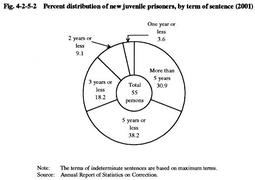| Previous Next Index Image Index Year Selection | |
|
|
2 Trend of imprisonment and characteristics of juvenile prisoners The trends in the number of new juvenile prisoners after 1946 has shown a generally downward trend with some fluctuations, after hitting a peak when the age limit for the application of the Juvenile Law was revised upward from under 18 to under 20 in 1951.
New juvenile prisoners in 2001 numbered 55 (up from 50 in the previous year), including 3 females. Fig. 4-2-5-1 shows the percent distribution of new juvenile prisoners in 2001 by age. The change in each year is small, and the newly convicted juvenile prisoners at 18 and 19 years of ages stood at about 80%. Fig. 4-2-5-2 showed the percent distribution by term of sentence. Of these, all of the 55 prisoners received indeterminate sentences . By type of penalty, all of prisoners were sentenced to imprisonment with labor (46 persons in the previous year were sentenced to imprisonment with labor, and 4 prisoners were sentenced to imprisonment without labor in the previous year). By type of offense, 52 committed penal code offenses, while the other 3 committed special law offenses. The most common penal code offense was rape or rape resulting in death or bodily injury (12 prisoners). This was followed by bodily injury resulting in death (9 prisoners), professional negligence in resulting death or bodily injury (8 prisoners), homicide (4 prisoners), bodily injury (4 prisoners), larceny (4 prisoners), and robbery resulting in death or bodily injury (4 prisoners). Fig. 4-2-5-1 Percent distribution of new juveniles prisoners, by age (2001) Fig. 4-2-5-2 Percent distribution of new juvenile prisoners, by term of sentence (2001) |

